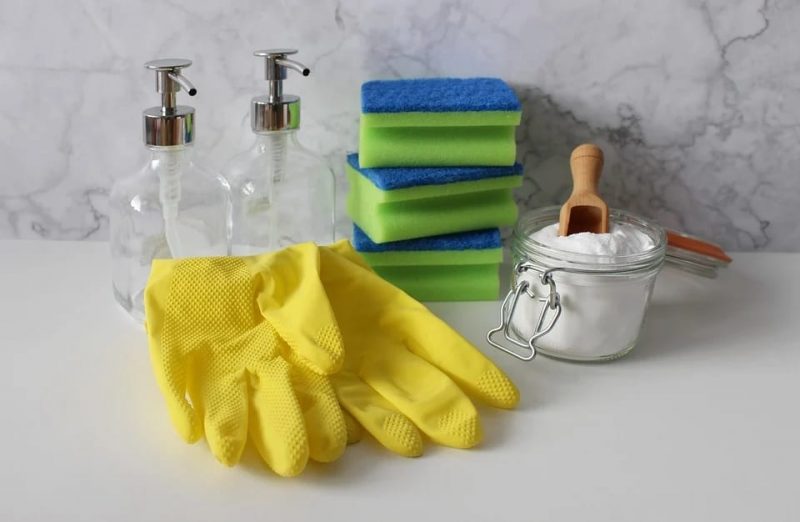It only takes two steps to master how to get mold out of a mattress. You might be thinking that cigarette stench is the only tricky issue one can face with mattress clean-up. Another problem that might arise is mold growth.
Sometimes, mold can still develop even if we’re being mindful of getting our mattresses wet. Perhaps it’s humid in your room, or you missed a spill. Regardless, you can still recover your bed and remove the mold using this two-step guide.

How To Get Mold Out Of A Mattress At Home
Step #1. Vacuum and scrub the mattress
Before the primary cleaning process, you need to vacuum your bed first. This will remove the dust particles, dander, and other build-ups on the surface that can encourage the spread of mold spores. Remember that some people might be allergic to mold spores, and it can cause itchiness, coughing, or irritation.
Once you’ve finished vacuuming the surface, you can start scrubbing the affected areas. Use a solution of warm water and isopropyl alcohol at equal parts to get rid of mold. Soak a cloth in a container with this mixture, wring the excess liquid, and scrub the moldy parts of the bed.
A useful technique to remove mold thoroughly is going in a circular motion while scrubbing. You can also reach the moldy areas’ outer parts to ensure that you’ve cleaned the mattress thoroughly. However, you don’t need to oversaturate or get your bed soaked throughout the process.
Step #2. Rinse and dry thoroughly
Excess moisture can encourage fungal growth, so be mindful when cleaning your mattress with liquid. After you scrubbed off the moldy parts, use another cloth soaked and wrung in warm water to get rid of the solution. Dab the surface to dry the bed and mist with a disinfectant.
Please check your mattress label if there are disinfectants that you can use to avoid damaging the mattress. Finally, you can let your bed air dry outside on a sunny day. The heat should inhibit mold growth and ensure that your mattress has dried thoroughly.
If the weather is humid, you can place your mattress in a well-ventilated room with circulating fans. You can also hasten the process with a heatless hairdryer. Note to only use your mattress once it dries completely as dampness might re-encourage mold growth.
How To Prevent Mold Growth On Mattress
Monitor moisture
Humidity is ideal for fungal growth, so monitoring the moisture in your room will keep mold at bay. If your region is known for being humid, it’s best to have a hygrometer in the room. This device will monitor your humidity so that you can keep the room conditions within the ideal levels.
Health experts recommend having 40 to 50% humidity indoors for safety. Furthermore, you can also use a dehumidifier to prevent dampness and an air purifier for maintaining air quality. Some purifiers can even eliminate the spores to avoid allergies and health issues from mold.
Maintain air circulation
Another factor that can prevent mold growth is to ensure that your bed sits on a base with adequate air circulation. A slatted foundation allows this because air can freely flow under your bed. You can also open your windows occasionally or add a fan in the room to further discourage fungal growth.
Does Bleach Kill Mold On A Mattress?
Unfortunately, bleach is incapable of killing mold on mattresses. Instead, you can use it to remove mold traces as long as the material is impermeable. Mold tends to penetrate deeply, and wiping the surface won’t remove what’s underneath that can return after some time.
You also have to remember that you can’t use bleach on some mattresses because it can deform or damage the materials. Some useful alternatives to this reactive chemical are hydrogen peroxide, vinegar, and tea tree oil. Still, be mindful of what you apply to your mattress to avoid issues.
What Causes Black Mold On Mattress?
Moisture and bacteria can encourage the growth of black mold in your bed. However, it’s worth noting that there is no single black mold, and the one that you might notice is the Stachybotrys atra. While there is no scientific proof that exposure to black mold is more dangerous, it’s still best to eradicate this issue as soon as possible.
Is Mold On A Mattress Dangerous?
Mold on the mattress is not only disgusting, but it also puts you at risk for health issues. Some people can be more sensitive to mold, and it can lead to difficulty in breathing, asthma, and even allergies. While it may not immediately cause debilitating conditions like cancer, always be on the lookout for mold on your mattress and practice prevention at all times.
Conclusion
If you notice fuzzy spots and discolorations on your bed, you might be dealing with mold. You can quickly master how to get mold out of a mattress by vacuuming the surface and scrubbing the affected areas with a solution of warm water and isopropyl alcohol.
Afterward, spray your mattress with a disinfectant to discourage the regrowth of mold. Then, wipe the surface to get rid of excess moisture and let your bed air dry thoroughly. You can keep issues like this at bay by maintaining humidity and air circulation in your room.
